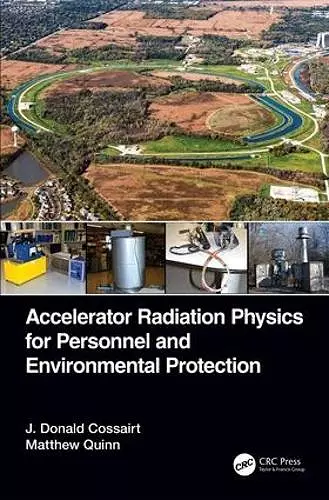Accelerator Radiation Physics for Personnel and Environmental Protection
Matthew Quinn author J Donald Cossairt author
Format:Hardback
Publisher:Taylor & Francis Ltd
Published:14th May '19
Currently unavailable, and unfortunately no date known when it will be back
This hardback is available in another edition too:
- Paperback£47.99(9780367779849)

Choice Recommended Title, January 2020
Providing a vital resource in tune with the massive advancements in accelerator technologies that have taken place over the past 50 years, Accelerator Radiation Physics for Personnel and Environmental Protection is a comprehensive reference for accelerator designers, operators, managers, health and safety staff, and governmental regulators.
Up-to-date with the latest developments in the field, it allows readers to effectively work together to ensure radiation safety for workers, to protect the environment, and adhere to all applicable standards and regulations.
This book will also be of interest to graduate and advanced undergraduate students in physics and engineering who are studying accelerator physics.
Features:
- Explores accelerator radiation physics and the latest results and research in a comprehensive single volume, fulfilling a need in the market for an up-to-date book on this topic
- Contains problems designed to enhance learning
- Addresses undergraduates with a background in math and/or science <
"This book has its origins in a graduate course first taught at the US Particle Accelerator School in 1993. The objective of the course and of the book is to address the major radiation physics issues that are relevant to the wide spectrum of particle accelerators in use across the world today. To attain this goal, Cossairt and Quinn (both, Fermi National Accelerator Lab) first develop the mathematical and physical techniques and concepts associated with modern particle accelerators, covered in chapters 1 and 2. Altogether, the authors have attained their stated objective of providing "a comprehensive reference for accelerator designers, operators, managers, health and safety staff, and governmental regulators." The major topics dealt with in detail are prompt radiation fields due to electrons (chapter 3), prompt radiation fields due to protons and ions (chapter 4), unique low-energy radiation phenomena (chapter 5), shielding materials and neutron energy spectra (chapter 6), and induced radioactivity in accelerator components and environmental media (chapters 7 and 8). The ninth and final chapter is particularly useful, covering radiation protection instrumentation at accelerators. This textbook is mainly written for people whose work will involve particle accelerators."
— A. M. Strauss, Vanderbilt University, in CHOICE, January 2020
"Don Cossairt and Matthew Quinn’s recently published book summarises both basic concepts of the propagation of particles through matter and fundamental aspects of protecting personnel and environments against prompt radiation and radioactivity. It constitutes a compact and comprehensive compendium for radiation-protection professionals working at accelerators. The book’s content originates in a course taught by Cossairt, a longstanding and recently retired radiation expert at Fermi lab, at numerous sessions of the US Particle Accelerator School (USPAS) since the early 1990s. It is also available as a Fermilab report, which has stood the test of time as one of the standard health-physics handbooks for accelerator facilities for more than 20 years. Quinn, the book’s co-author, is the laboratory’s radiation-physics department manager.
The book begins with a short overview of the physical and radiological quantities relevant for radiation-protection assessments, and briefly sketches the mechanisms for energy loss and scattering during particle transport in matter. The introductory part concludes with chapters on the Boltzmann equation, which in this context describes the transport of particles through matter, and its solution using Monte Carlo methods. The following chapters illustrate the radiation fields that are induced by the interactions of electron, hadron and ion beams with beamline components. The tools described in these chapters are parametrised equations and handy rules-of-thumb. Graphs of representative particle spectra and yields serve for back-of-the-envelope calculations and describe the fundamental characteristics of radiation fields.
The second half of the book deals with the practical questions encountered in everyday radiation-protection assessments, such as the selection of the most efficient shielding material for a given radiation field, the energy spectra to be expected outside of the shielding, where personnel might be present, and lists of the radiologically relevant nuclides that are typically produced around accelerators. It also provides a compact introduction to activation at accelerators. The final chapter gives a comprehensive overview of the radiation-protection instrumentation traditionally used at accelerators, helping the reader to select the most appropriate detector for a given radiation field.
Some topics have evolved since the time when the material upon which the book is based was written. For example, the rules-of-thumb presented in the text are nowadays mostly used for cross-checking results obtained with much more powerful and user-friendly Monte Carlo transport programs. The book gives many tools necessary for obtaining rough but valuable estimates for setting up simulations and crosschecking results."
—Stefan Roesler, CERN, in CERN Courier, Vol 60 No.5 (September/October 2020)
ISBN: 9781138589018
Dimensions: unknown
Weight: 739g
306 pages